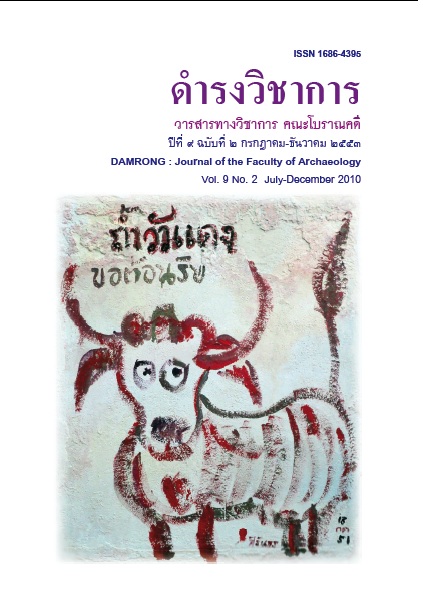ANALYSIS OF DRAMATIC AND MUSICAL SCENES IN THAI BUDDHIST ART
Keywords:
ศิลปกรรม, นาฏดุริยางค์ศิลป์Abstract
The dissertation’s objectives are to study and analyze scenes of dance and music appearing in Thai Buddhist art, to comparatively study the relations between specific forms and beliefs that are found in several countries, and to study the characteristics of these forms and their meanings.
The study was conducted by gathering information from documents, archeological sites, architecture, sculptures and paintings. Both Theravada and Mahayana data was included in this analytic study along with references to other kinds of art. The studies have found that the dance and music scenes pay homage to the Lord Buddha, whilst the sculptures are highly respected and are used in ceremonies as auspicious objects. These art objects are utilized in building ornamentation to both spread and introduce Buddhism, as well as to depict the monastic areas and to decorate everyday objects.
These Buddhist objects/artworks are based on the Lord Buddha’s life stories, stories of the Buddhist divine beings, Jatakas, and animals. The Lord Buddha’s story of life is from his birth to his nirvana. The Buddhist divine beings are Vajrasatva, Trailokyavijaybodhisatva, Vajrapanibodhisatva, Hevajra, Yogini or Dakini, Apsara and Devata. Jatakas are normally from the Dasajatijataka i.e. Mahajanakajataka, Bhuridattajataka, Naradajataka, Vidurajataka, and Vessantarajataka, the Jatakas from non-dasajatijataka are Sudhanajataka, Candagadhjataka, Gandhakumarajataka; those of the non-content were normally found to have only decorative function on both buildings and objects. The Buddhist works of art show strong resemblance to Indian art forms, as well as Burmese Art, Indonesian Art and Khmer Art.
Although in the idea of, Silas, Theravada Buddhist precepts, there is an idea, appearing as the seventh precept, to refrain from dancing, singing, music and going to shows. In the Buddha’s story of life, music and dance are represented by Kilesa and Tanha, defilement and craving. In Mahayana Buddhism dancing postures of the angels represent the defeat of Avijja, ignorance, and are found in ceremonies practiced by Tantric Buddhists.
References
ผาสุข อินทราวุธ, พุทธปฏิมาฝ่ายมหายาน, 73.
Gosta Liebert, Iconographic Dictionary of the Indian Religious Hinduism, Buddhism, Jainism,104.
Jukka O. Miettinen, Dance Images in Temples of Mainland Southeast Asia (Helsinki: Theatre Academy, 2008), 183
Pratapaditya Pal, Art from Sri Lanka and Southeast Asia (New Heaven and London: Yale University Press, 2004), 148.
Downloads
Issue
Section
License
บทความนี้เป็นผลงานของข้าพเจ้าแต่เพียงผู้เดียว และ/หรือเป็นผลงานของข้าพเจ้าและผู้ร่วมงาน ตามชื่อที่ระบุในบทความจริง และเป็นผลงานที่มิได้ถูกนำเสนอหรือตีพิมพ์ที่ใดมาก่อน


